Count Raggi’s and Lesser Birds of Paradise, males and females. Details from two paintings by W. T. Cooper. Both oils on canvas, c. 2000.
Count Raggi’s and Lesser Birds of Paradise, males and females. Details from two paintings by W. T. Cooper. Both oils on canvas, c. 2000.
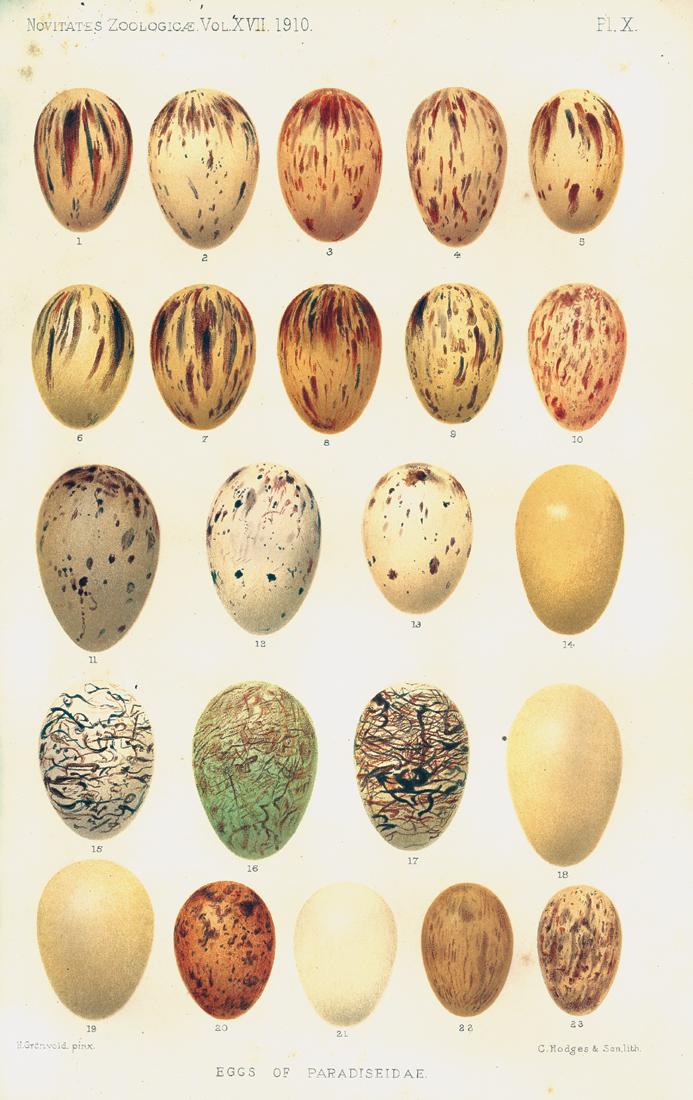
The Eggs of some Birds of Paradise, together with the eggs of a few Bower Birds. There is considerable similarity between the eggs of certain species, yet sometimes a surprising variation between individual eggs of birds belonging to the same species. Chromolithograph by Henrik Gronvold from Novitates Zoologicae (1910).
(Top row, from left). Count Raggi’s Bird of Paradise; Twelve-wired Bird of Paradise; Count Raggi’s Bird of Paradise; Prince Rudolf’s Blue Bird of Paradise; Queen Victoria’s Riflebird.
(Second row, from left). Lesser Bird of Paradise; Lesser Bird of Paradise; Princess Stephanie’s Astrapia; Magnificent Riflebird; Trumpet Bird.
(Third row, from left). Curl-crested Manucode; Glossy-mantled Manucode; Crinkle-collared Manucode; White-eared Catbird.
(Fourth row, from left). Great Bower Bird; Great Bower Bird; Fawn-breasted Bower Bird; Tooth-billed Bower Bird.
(Fifth row, from left). Black-eared Catbird; Lawes’ Six-wired Bird of Paradise; Newton’s Bower Bird; Superb Bird of Paradise; Superb Bird of Paradise.
Alfred Wallace was not at all sure why male birds of paradise had such extravagant plumes. On the face of it, they contradicted his theory of evolution by natural selection drafted four years after his arrival in Indonesia and subsequently read out to a meeting of the Linnean Society in London during 1858. The theory had been summarised as ‘the survival of the fittest’. But how could huge plumes that made a bird extremely conspicuous, that in some instances impeded it in flight and that in all cases clearly made great demands on an individual’s physical resources to grow – how could such things aid a bird’s survival?
Wallace recognised, of course, that a bird’s plumage may carry colours and patterns because, as he put it, ‘one of the first needs of a new species would be to keep separate from its nearest allies and that this could be done by some easily seen marks of difference’. Female birds of paradise, however, like the females of many other species, are plain and drab and lack the male’s extravagant colours. Why should that be? Wallace suggested that it was because such bright plumage would make a female, sitting on her nest, very conspicuous and therefore very vulnerable to predators. In support of that explanation, he pointed out that many birds in which both sexes are brightly coloured – such as kingfishers and trogons – make their nests in tunnels where the female’s bright colours are invisible and therefore no liability. But even he must have recognised that plumes of a bird of paradise were considerably more spectacular than is necessary simply to identify species.
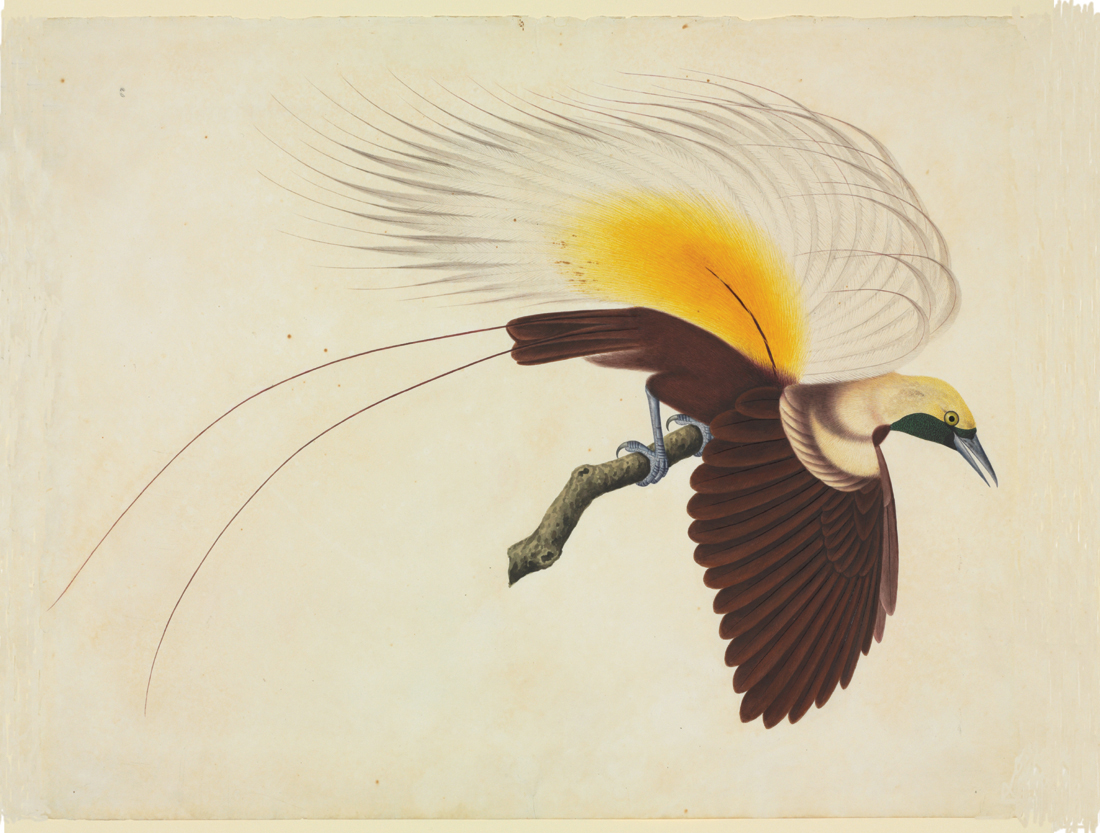
An early attempt to show a plume bird of paradise in display. Anonymous, c.1820. Watercolour, 48 cm × 60 cm (19 in × 24 in). This is one of a series of paintings of birds (now in the Natural History Museum, London) commissioned in Canton by John Reeves, an English resident.
Charles Darwin, whose paper on natural selection had been read out at the same historic Linnean meeting, also saw the difficulty. He, however, proposed a fundamentally different explanation, a process that has little to do with the survival of the fittest. He called it ‘sexual selection’, and he explained it in an even longer book than On The Origin of Species, a book which he entitled The Descent of Man and Selection in Relation to Sex. According to this explanation, male birds of paradise display their plumes to females who then – having surveyed all available candidates – choose the one that most appeals to them visually.

Count Raggi’s Bird of Paradise, two males displaying to a female. W. T. Cooper, c.2000. Oils on canvas, 90 cm × 125 cm (35 in × 52 in). Private collection.
Wallace would have none of it. In reviewing The Descent of Man he wrote, ‘Are we to believe that the actions of an ever varying fancy for a slight change of colour could produce and fix the definite colours and markings which actually characterise species?’ Furthermore, he said, it was unacceptable to suggest that birds had an aesthetic sense. That would be crediting a bird with a human characteristic for which there was no evidence. It would be anthropomorphism at its most unjustified.
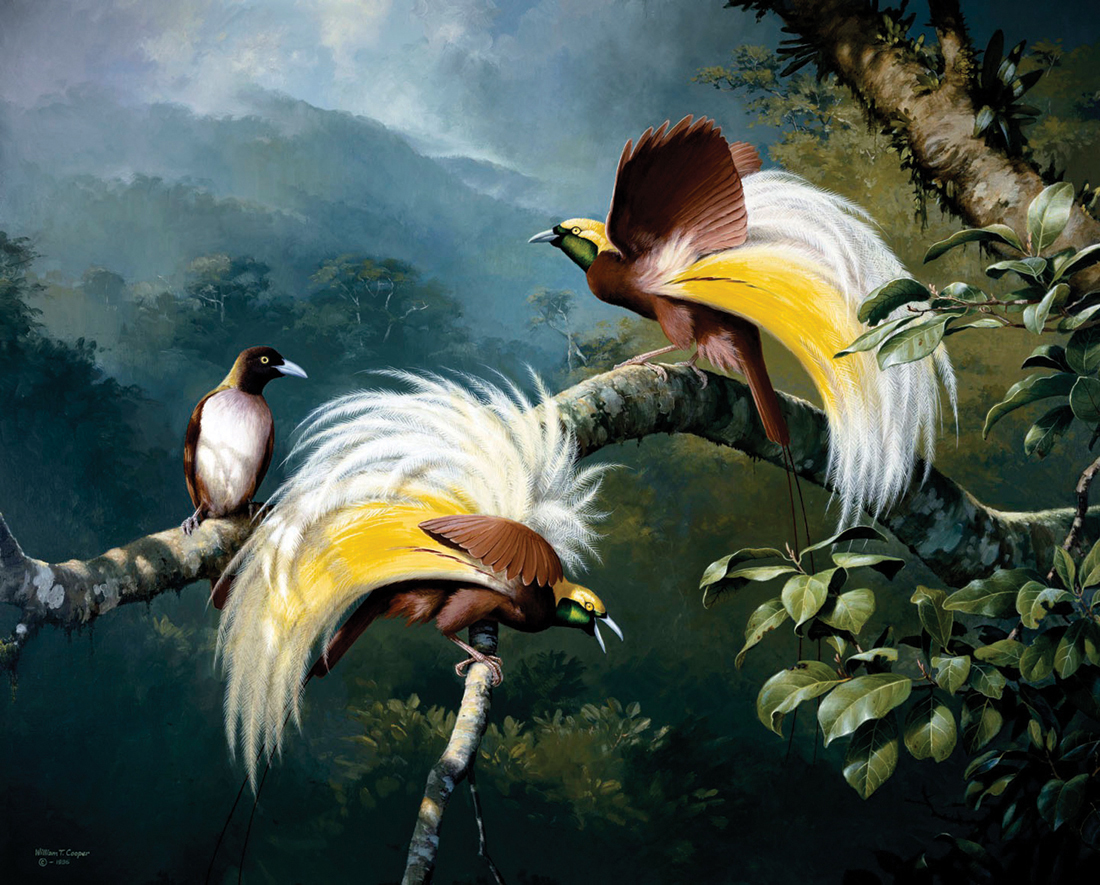
Lesser Bird of Paradise, two males displaying to a female. W. T. Cooper, c.2000. Oils on canvas, 90 cm × 125 cm (35 in × 52 in). Private collection.
Darwin emphatically rebutted the charge. ‘Birds,’ he wrote, ‘are the most aesthetic of all animals, excepting of course man, and they have the same taste for the beautiful as we have.’ He was writing in this particular instance about bird song, but the statement applied even more obviously and spectacularly to the plumage of birds of paradise. That he was right has been proved subsequently by a whole range of experiments. Ornithologists have both snipped off and added to the ‘eyes’ on a peacock’s wonderful tail-train and shown that peahens will always select the male with the greater number. A similar thing is true for African whydah birds. Here the males, during the breeding season, develop long glossy black tail feathers which they show off to visiting females. Trim a successful male’s tail and he will be spurned. Add to it, and a bird that had only produced a medium-sized tail would suddenly become – no doubt to his considerable gratification – suddenly favoured. The same, doubtless, would be true for birds of paradise, though seemingly no-one has been unfeeling enough to inflict such barbarity on one of them.
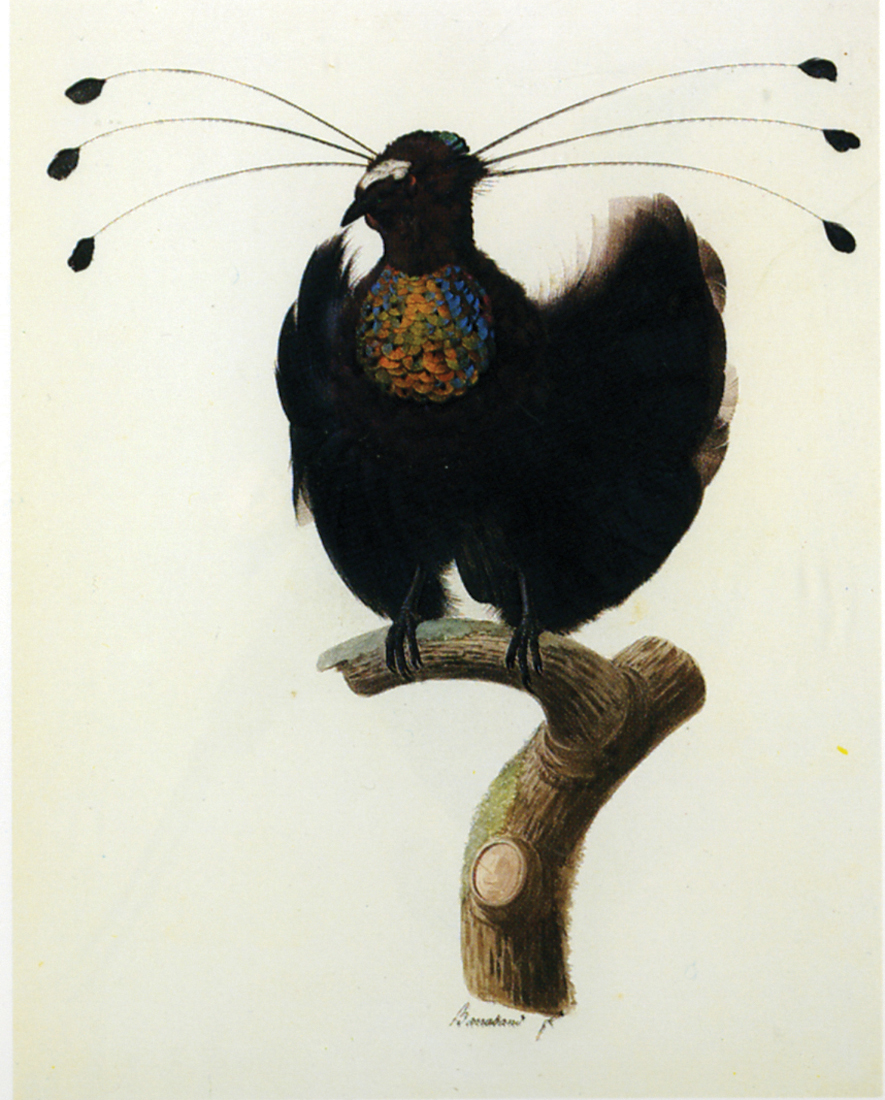
Arfak Six-wired Bird of Paradise, male. Jacques Barraband, c.1800. Watercolour, 52 cm × 38 cm (21 in × 15 in). Private collection.
Greater Birds, the species that Wallace first observed in display, gather together for these competitions, usually in a tall tree with relatively open upper branches where the birds can be easily seen as a group. There may be as many as twenty or so and they occupy their display tree for most of the year though their numbers are usually highest between December and February. The arrival of a female in nearby branches brings a sudden chorus of harsh cries from the assembled males as they lower their wings and erect their golden plumes above their backs. If a female hops down to perch beside one of the males his dance becomes more passionate as he moves through several balletic phases, with the female, squatting and apparently impassive, close by. At the climax of his performance, which may take less than a minute, the chosen male leaps on the female’s back and, as is the way with birds, copulates within a second or so. After that the female flies away and will not return that season.
Does she really, when she arrives, assess all the males individually to pick her winner? Or does she choose the one who is performing on one particular perch? The fact is that the great majority of copulations in a display tree take place with one single male, the possessor of a perch that seems to be particularly favoured. Males compete for perches by physical fighting and by displaying their plumes. So differences in plume quality may also be significant to other males as well as to females.
These massed displays are performed not only by all species of the genus Paradisaea (except for the Blue Bird) but also by the Standardwing and all Astrapia species. Such assemblies are known among ornithologists as ‘leks’, a Swedish term they originally used for the assemblages of male ruffs, small wading birds that gather and display in similar competitive groups on Scandinavian seashores.
It might seem that a male Parotia, pirouetting alone on his carefully prepared arena on the ground, has adopted a rather different tactic for attracting a female. But he is not as isolated as he seems. Parotia arenas, scattered through the forest, in fact form a coherent group. Each of them is within earshot of a neighbour, so it is easy for a female to tour from one arena to another in order to assess the quality of rival males.
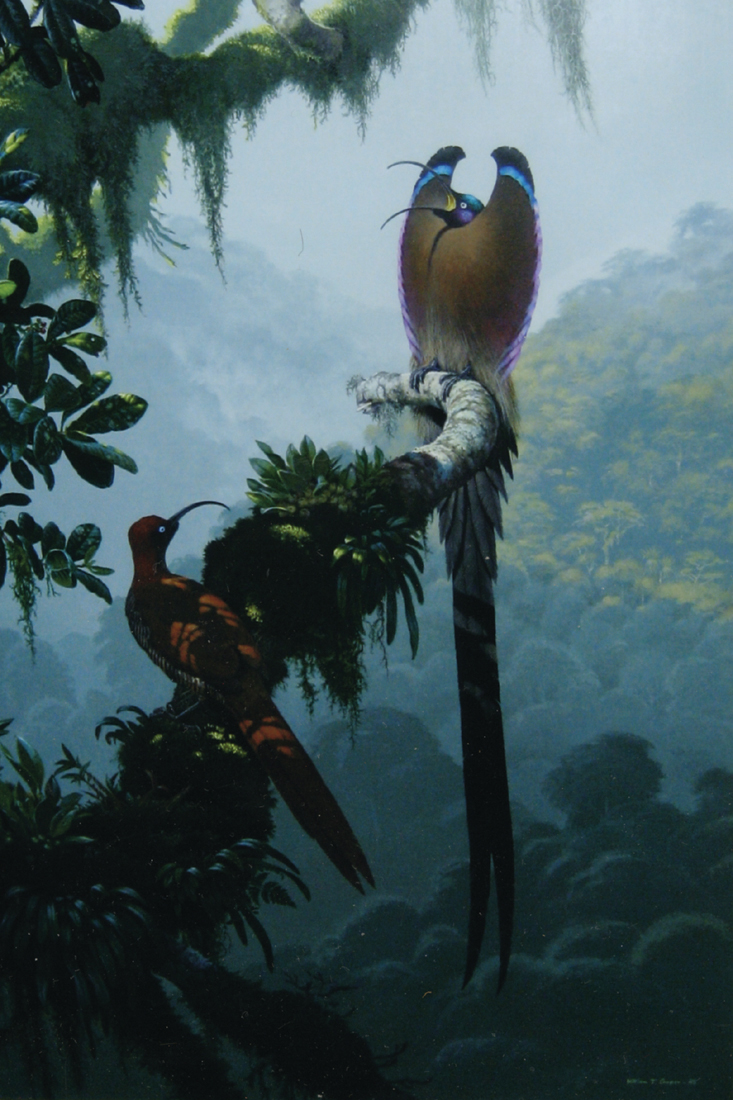
Male Brown Sicklebill displaying to a female. W. T. Cooper, 1989. Acrylic on panel, 102 cm × 69 cm (40 in × 27 in). Private collection.
Ornithologists call this kind of grouping an ‘exploded lek’, though the term is perhaps unfortunate since it implies that the arrangement is derived from a normal lek, whereas it is just as likely to be the other way round.
It is possible that the King Bird too uses an exploded lek, though the evidence is not conclusive. The males of other spectacular species – the Magnificent, the King of Saxony, the Superb, the Twelve-wired and the four Sicklebills – all display individually without reference to their rivals. The female must then travel around the forest, assessing which of them has the best-kept arena, the most varied vocal repertoire and the most brilliant and exciting plumage.
A cameraman filming bird of paradise display will of course wish to complete his sequence with a shot of the copulation. Things are comparatively easy for him when filming a massed lek like that of the Greater Bird. If he sees one copulation but fails to focus his camera on it before it finishes, he need not be concerned. All he has to do is to keep his camera trained on that particular branch and the next female to arrive at the lek will almost certainly make for the same place and be mated by the same male.
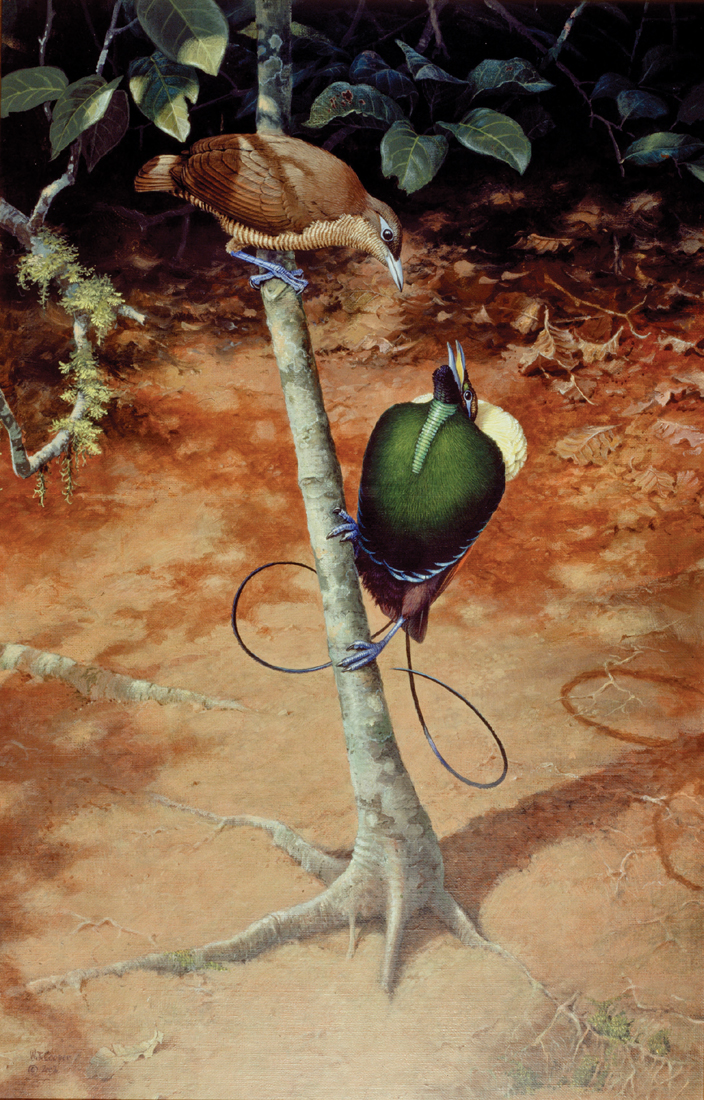
Male Magnificent Bird of Paradise displaying to a female. W. T. Cooper, c.1990. Acrylic on panel, 81 cm × 71 cm (32 in × 28 in). Private collection.
Things are not so easy when filming species that have exploded leks or independent ones. If the cameraman is wise and has the chance, he will inspect other display grounds in the neighbourhood and choose the one that seems to him to be the best kept by the smartest-looking male. If he picks the wrong one, he will be almost as disappointed as the male bird himself.

Count Raggi’s Bird of Paradise, male and female. W. T. Cooper, 1981. Watercolour, 60 cm × 45 cm (24 in × 18 in). Private collection.
Male birds spend most of their year close by the site where they display. A female, however, once she has mated, has to leave for she has to lay her eggs and rear her chicks. And since her momentary partner is still strutting his stuff on his display ground, she has to do all that entirely by herself.
It follows, therefore, that such polygamous systems can only develop in places where there is plenty of food easily available. And that is indeed the case in the New Guinea forests. All birds of paradise feed on fruit. Most supplement that with insects, but fruit of some sort is the most important element and that is available throughout the year.
The system also has a consequence for the male – a consequence that ultimately transfigures him. If a young male appears who is marginally better endowed than his fellows – with the colour or size of plumes that the local females prefer – then the genes that gave him that characteristic will quickly spread through the local population. And this will take place more swiftly than if the gene responsible becomes submerged in the next generation among those of other breeding males in the neighbourhood. If the females maintain their preference for this quality, year after year, then these decorations will become even more exaggerated, generation after generation, as the local champion maintains his exclusive access to the females and denies any competing males a place in the local gene pool. Evolutionists call this snow-balling effect ‘runaway sexual selection’. And it is this that has led to male birds of paradise acquiring such outsized and bizarre plumes, even though these plumes may in practice be a handicap from many points of view.
Males do not, however, acquire their plumes until they are several years old – seven in the case of the Greater and Lesser Birds. Until that time, they look very like the females of their species. What is more, young unplumed males frequently spend some time around a lek, watching what goes on and, presumably, learning the dances being performed by their elders. They look so like females that occasionally a plumed male will attempt to mate with one of these young bachelors under the impression, clearly, that they really are of the opposite sex.
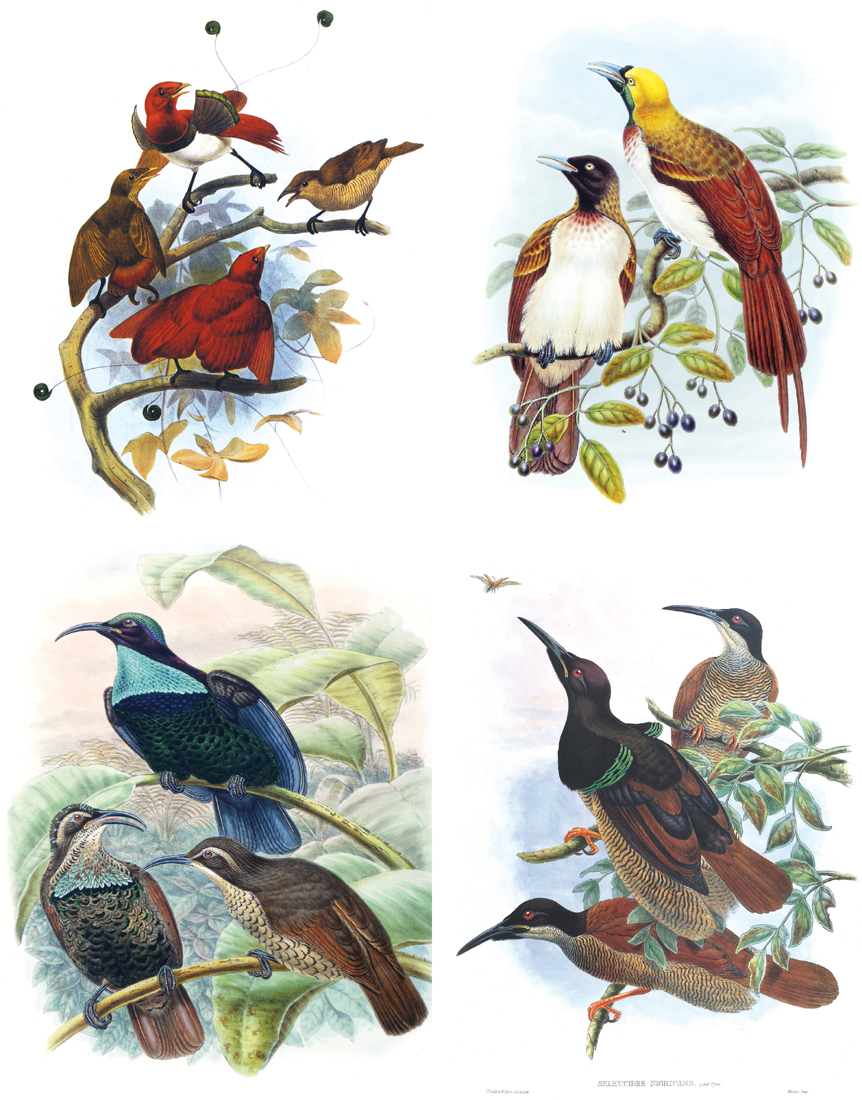
Four images each showing a male bird in a transitional stage of plumage development. Males begin with feathering like that of a female and pass through several stages before acquiring full adult plumage.
(Top, left). King Birds of Paradise, two adult males and an immature developing tail decoration, with a female. Hand-coloured lithograph by Joseph Wolf and Joseph Smit from D. G. Elliot’s Monograph of the Paradiseidae (1873).
(Top, right). Lesser Birds of Paradise, a female with an immature male growing extended tail wires. Hand-coloured lithograph by William Hart from R.Bowdler Sharpe’s Monograph of the Paradiseidae (1891–98).
(Bottom, left). Paradise Riflebirds, male and female, with an immature male showing incomplete breast shield and undeveloped feathers of head and stomach. Hand-coloured lithograph by William Hart from R.Bowdler Sharpe’s Monograph of the Paradiseidae (1891–98).
(Bottom, right). Twelve-wired Birds of Paradise, two females and an immature male that lacks ornamental wires and shows the barred underside typical of a female. Hand-coloured lithograph by William Hart and John Gould from Gould’s Birds of New Guinea (1875–88).
It also seems equally likely that plumed males, especially perhaps those that are sexually frustrated by the mating monopoly of the dominant male in the lek, will pounce on a female of another closely related species should she appear beside a display ground. Since the species in the family are, in spite of the difference in the plumage of the males, closely related, these ‘illicit’ couplings stand a chance of producing fertile offspring – hybrids.
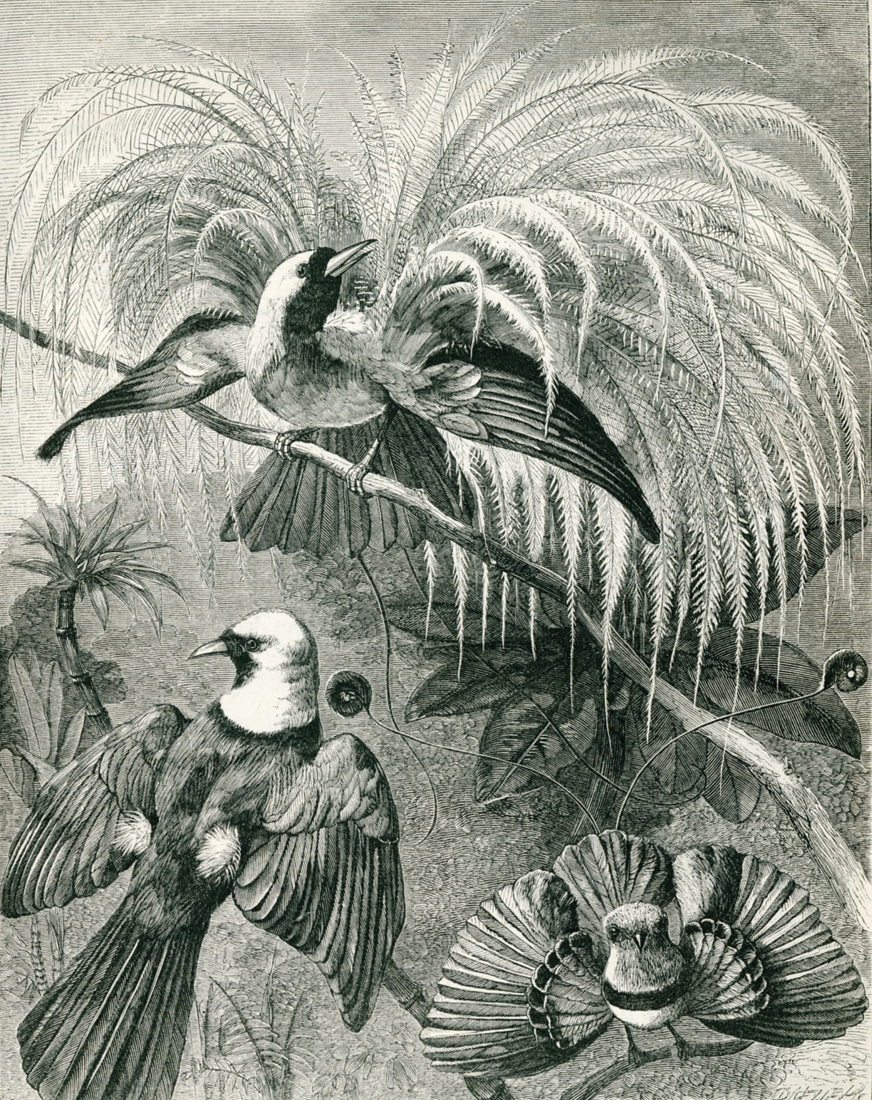
Sexual displays of birds of paradise fancifully imagined by someone who never saw them. A nineteenth-century engraving of a Lesser Bird (derived from Wolf’s depiction –) displaying with a King, by an unknown artist, from J. G. Wood’s Illustrated Natural History (1872). The third bird appears to be an immature Lesser Bird.